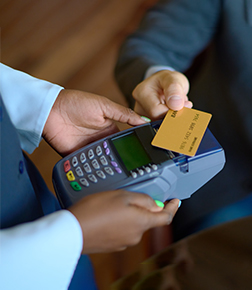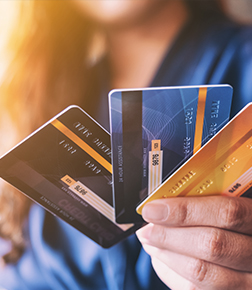In today's fast-paced digital age, the ability to make secure online
payments is integral
to both businesses and consumers. Payment gateways play a pivotal role
in facilitating
these online transactions.
These mystique gateways ensure that sensitive financial information is
protected and
funds are transferred seamlessly. In this comprehensive guide, we will
explore the world
of payment gateways.
Most importantly we will understand their significance, how they work,
and the critical
role they play in the fintech domain.
We are living in the era of digital transactions. Here, payment gateways
stand as the
sentinels of secure online payments. Using these
digital
enablers
we can easily bridge the gap between businesses and
consumers.
Which not only ensure seamless monetary exchanges but also the safe
transaction. In this
write up, we embark on a journey to understand the world of payment
gateways.
Let’s start with the fundamentals.

Payment gateways are the virtual bridges that connect a customer's financial
institution with
a merchant's payment processing system. They are the digital counterparts to
the physical
point-of-sale terminals used in traditional stores.
Payment gateways act as intermediaries, responsible for securely
transmitting payment
information between the customer's bank and the merchant. They provide a
layer of protection
by encrypting sensitive financial data and ensuring that it remains
confidential during
online transactions.
In simple words, payment gateways are the digital gatekeepers of the
financial world,
facilitating the transfer of funds across the digital landscape..
To understand the inner workings of payment gateways, it's essential to break down the process step by step:
1. Initiation : The payment process commences when a customer
initiates a
transaction. This could be the result of making a purchase on an
e-commerce website,
subscribing to a service, or any other action that involves a financial
exchange.
2. Data Encryption : Once the customer enters their payment information, the payment gateway swiftly encrypts this data. Encryption converts the information into an indecipherable code, ensuring its security during transmission.
3. Transaction Routing : The encrypted data is then transmitted to the payment gateway's secure server. The payment gateway undertakes the task of routing this information to the relevant financial institutions. Authorization: The customer's
4. Authorization : The customer's bank or credit card provider receives the transaction request, and an authorization process ensues. This typically involves verifying the customer's account balance, ensuring the payment source is valid, and checking for any suspicious activity.
5. Approval or Decline : Based on the results of the authorization process, the customer's financial institution communicates an approval or decline signal back to the payment gateway.
6. Completion : In the case of approval, the payment gateway communicates the good news to the merchant, allowing the transaction to proceed. The customer's account is debited, and the merchant's account is credited. If declined, the payment gateway communicates this to the merchant, and the transaction is halted.

There are various forms of payment gateways, each catering to different business needs. Here are the primary types:
Hosted Payment Gateways : In this setup, the customer is redirected to a third-party gateway's page to complete the payment. While this can simplify security compliance for the merchant, it may redirect customers away from the website.
Self-hosted Payment Gateways : These gateways allow customers to enter payment information directly on the merchant's site. While this offers more control over the customer experience, it also places greater responsibility on the merchant for security and compliance.
Integrated Payment Gateways : These gateways are seamlessly integrated into the merchant's website or application. This integration provides a cohesive customer experience but requires more development effort.
Understanding these fundamental aspects of payment gateways is crucial for both businesses and consumers. It paves the way for secure and efficient online transactions, setting the stage for the digital payment landscape we navigate daily.
Payment gateways have emerged as the unsung heroes of secure online
commerce. These
intricate systems ensure the swift and secure transfer of funds between
customers and
businesses, underpinning the global economy's digital transformation.
In this section, we explore the significance of payment gateways,
focusing on their
crucial roles in bolstering security and expanding global reach.
One of the primary functions and, arguably, the most critical role of payment gateways is to fortify the security of online transactions. This becomes particularly crucial in an age where data breaches and cyber threats loom ominously. Payment gateways act as formidable guardians against these digital perils.
Encryption at the Core : The bedrock of payment gateway security lies in encryption. Sensitive financial data, such as credit card numbers, bank account information, and personal details, are transformed into encrypted code during transmission. This encryption renders the data virtually indecipherable to potential cybercriminals, safeguarding it from theft or misuse.
Data Security Protocols : Payment gateways are fortified with data security protocols that align with industry standards and best practices. Among these, the Payment Card Industry Data Security Standard (PCI DSS) is paramount. Compliance with PCI DSS ensures that payment gateways adhere to stringent security measures, making it exceedingly challenging for malicious actors to breach the system.
Risk Assessment and Fraud Detection : Payment gateways employ sophisticated risk assessment algorithms and fraud detection tools. These systems monitor transactions in real time, scrutinizing each for anomalies or suspicious activity. Any transaction that deviates from the norm can trigger alerts, enabling immediate intervention to thwart potential fraud.
Payment gateways offer businesses a passport to the global marketplace. The
ability to accept
payments in multiple currencies, cater to a diverse international customer
base.
Moreover, it facilitates cross-border transactions empowers businesses to
expand their
horizons in following ways:
Currency Flexibility : In the digital realm, currency barriers dissolve. Payment gateways enable businesses to accept payments in a myriad of currencies, making it convenient for customers around the world. This flexibility not only enhances the customer experience but also broadens the market reach.
International Transactions : Cross-border commerce has become the norm. Payment gateways ensure that businesses can seamlessly conduct international transactions. Customers from various corners of the globe can purchase products and services, while the payment gateway manages currency conversion and settlement.
Enhanced Customer Base : The global reach facilitated by payment gateways opens the door to a more extensive and diverse customer base. Businesses can tap into new markets, attracting a broader audience and diversifying their revenue streams.
The dual importance of payment gateways in bolstering security and expanding global reach is undeniable.
For businesses in the digital age, payment gateways are indispensable
tools in their
financial arsenal. These sophisticated systems empower merchants to
offer secure,
seamless online transactions, catering to an ever-expanding digital
customer base.
Here, let’s explore the merchant's perspective, focusing on integration
options and the
crucial process of selecting the right payment gateway.
Merchants have a variety of integration options when it comes to implementing payment gateways, each with its unique features and considerations:
Hosted Payment Gateway : In this setup, customers are redirected to a secure payment gateway page to complete their transactions. This option is popular for its simplicity and reduced security compliance requirements. However, it can lead to a break in the user experience as customers temporarily leave the merchant's site.
Self-Hosted Payment Gateway : Self-hosted gateways allow customers to enter payment details directly on the merchant's website. This approach provides more control over the customer experience and may keep customers engaged on the site. However, it places a greater responsibility on the merchant for security and compliance, which can be complex and resource intensive.
Integrated Payment Gateway : Integrated gateways are seamlessly embedded into the merchant's website or application. They provide a cohesive user experience and allow customers to complete transactions without leaving the site. This option offers the best of both worlds—control over the user experience and robust security measures. However, this type needs more expertise and development efforts

Selecting the right payment gateway is a critical decision for merchants. It influences the customer experience, security, and the ability to expand into global markets.
Here are key considerations when making this choice:
Security Features : Prioritize payment gateways that offer robust security features. Look for encryption standards, compliance with data security regulations like PCI DSS, and real-time fraud detection.
User Experience : The gateway should provide a seamless and user-friendly experience for customers. Complicated or lengthy checkout processes can lead to cart abandonment and lost sales.
Compatibility and Integration : Ensure that the chosen gateway integrates seamlessly with your existing e-commerce platform or website. Compatibility issues can lead to technical complications.
Global Reach : If your business has international aspirations, opt for a payment gateway that supports multiple currencies and offers international payment options.
Costs and Fees : Understand the pricing structure of the payment gateway. Different gateways charge various fees, including setup fees, transaction fees, and monthly fees. Consider how these costs align with your business's financial model.
Customer Support : Reliable customer support is essential. In case of technical issues or questions, responsive and knowledgeable support can be a lifesaver.

For customers, these gateways represent the bridge that connects
their desire to
shop and the gratification of acquiring products and services
online.
Let’s unravel the customer's perspective, with a focus on the magic
behind seamless
checkouts and diverse payment options.
The hallmark of an exceptional digital checkout experience lies in its seamlessness. Customers crave a process that is quick, convenient, and hassle-free, and payment gateways play a pivotal role in delivering just that.
Effortless Navigation : When customers arrive at the payment page, the last thing they want is a confusing labyrinth of forms and options. Payment gateways streamline this process, guiding customers through a logical and straightforward series of steps. This ensures that they can complete their transactions with ease.
Autofill and Convenience : Modern payment gateways often incorporate features like autofill and saved payment information. These innovations not only save customers time but also reduce the chances of errors during data entry. With a simple click, customers can populate payment details and proceed with their purchase.
User-Friendly Interfaces : Intuitive interfaces are a must. Customers should be able to understand the payment process immediately. Well-designed payment gateways present information clearly, such as the total amount, payment method options, and any additional charges.
Responsive Design : With the proliferation of mobile shopping, responsive design is vital. Payment gateways that adapt to various devices and screen sizes ensure that customers can easily complete transactions on smartphones and tablets.
The tireless dedication of payment gateways to security, reliability, and
innovation ensures
that the digital marketplace remains a vibrant and trusted space for
businesses and
consumers. These gateways act as both the shield and the bridge, fortifying
against the
threats of the digital realm and providing a conduit for commerce to
flourish.
As the digital landscape continues to evolve, payment gateways remain at the
forefront of
secure online commerce. This comprehensive guide aims to demystify these
crucial elements of
the fintech ecosystem, providing merchants and consumers with a deeper
understanding of
their functions, significance, and the ever-expanding possibilities they
offer for the
future of online payments.

We are living in the era of digital transactions. Here, payment gateways stand as the sentinels of secure online payments.

Fintech, short for financial technology, refers to the innovative use of technology to deliver financial services .